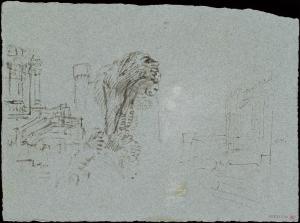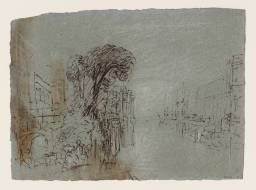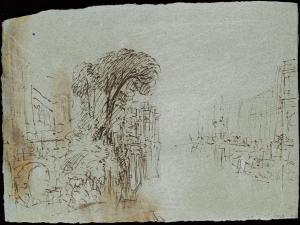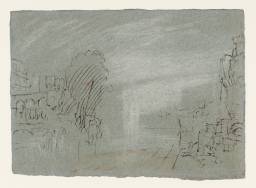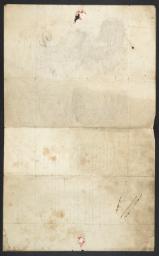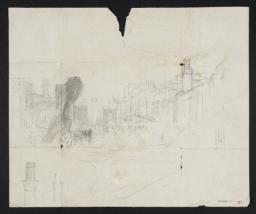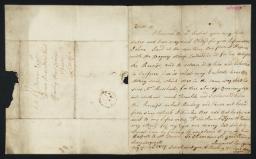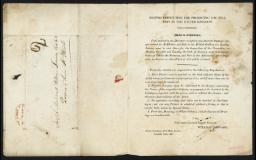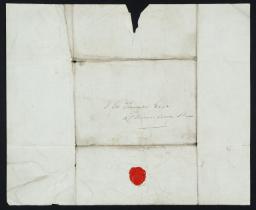Turner Bequest CCXXVII a 15, CCLX 7, 8, 10, CCLXIII a 7, 8, CCCXLIV 372
References
The technically miscellaneous drawings in this subsection are united by their subject matter, as studies for Turner’s large painting Dido Directing the Equipment of the Fleet, or The Morning of the Carthaginian Empire, exhibited at the Royal Academy in 1828 (Tate N00506).1 This was a classical seaport painting with the sun low over water and complex architecture in the manner of Claude Lorrain (1604/5–1682; see the overall Introduction to this section), forming a loosely defined triptych on the semi-mythical theme with Dido Building Carthage; or the Rise of the Carthaginian Empire, exhibited in 1815 (Turner Bequest, National Gallery, London)2 and The Decline of the Carthaginian Empire, shown in 1817 (Tate N00499).3
It appears that Turner had been drawn again to the seaport theme by his visit to John Nash at East Cowes Castle on the Isle of Wight in the late summer of 1827, and his experience of the atmosphere and bustle of regatta events at the broad mouth of the River Medina off Cowes (see the Introduction to the present author’s ‘Isle of Wight 1827’ section of this catalogue). The stay had led to the Claude-like painting East Cowes Castle, the Seat of J. Nash, Esq.; the Regatta Starting for their Moorings (Victoria and Albert Museum, London),4 also shown at the Academy in 1828 along with the more Dutch-influenced East Cowes Castle, the Seat of J. Nash, Esq.; the Regatta Beating to Windward (Indianapolis Museum of Art),5 both commissioned by Nash. Inspired by the playful atmosphere and setting of East Cowes Castle, a fourth painting, Boccaccio Relating the Tale of the Birdcage (Tate N00507),6 was shown on the same occasion (see under Tate D20844; Turner Bequest CCXXVII a 41); like Dido Directing the Equipment of the Fleet, it remained in Turner’s hands.
Early sketchbooks such as the large Calais Pier book, in use between about 1799 and 1805 (Tate; Turner Bequest LXXXI), contain many studies for paintings consciously echoing those of previous eras; the Calais Pier drawings were in themselves energetic black ink and white chalk exercises on blue paper in a long tradition, and ‘evidently reflect Turner’s sense of the Old Masters at his shoulder’ as Andrew Wilton has put it in comparing them to the four blue paper drawings here (D20818, D24843, D24844, D24846; CCXXVII a 15, CCLX 7, CCLX 8, CCLX 10).7 By this stage of Turner’s career it is unusual that so many preliminary drawings for a particular painting survive, presumably more by chance than design. The four in Calais Pier mode are in chalk and ink on the blue sheets Turner had recently begun to use on tour, torn neatly into small, portable rectangles (see the Introduction to the ‘East Cowes Castle’ subsection of ‘Isle of Wight 1827’). He used over a hundred such pieces while at East Cowes in 1827 (Tate; Turner Bequest CCXXVII a, CCXXVIII), and a comparable number in the autumn of that year at Petworth House, latterly employing bright gouache colours (Tate; Turner Bequest CCXLIV).
Since many of the Isle of Wight drawings on the same paper are themselves in ink and chalk, it seems likely that the four addressed here were done at that time, developing the theme of the white, mock-medieval castle above the water until the towers metamorphosed into elements of a classical harbour scene,8 subsequently greatly elaborated. Associated with the Isle of Wight material in the 1909 Inventory, the first of the four (D20818) was identified by Finberg as a study for the painting,9 while the remaining three, like some of the equally characteristic East Cowes topographical views (possibly not actually seen by Finberg), had been grouped with blue paper subjects ‘mostly connected with “French River” series’.10
The three other studies here are all on the backs of letters addressed to the artist, the contents of the first two each by coincidence being dated 19 November 1827. They perhaps suggest a habit of improvisation with whatever ephemera came to hand during the development of an idea; it is notable that a series of classical seaport variations catalogued elsewhere in this section survives in the form of tiny drawings on visiting cards, both Turner’s and others’ (Tate D34929–D34939; Turner Bequest CCCXLIV 431–439). Martin Butlin and Evelyn Joll suggested a drawing in the River sketchbook of about 1823–4 (Tate D17782; Turner Bequest CCIV 7a) as also relating to the 1828 painting11 but, as discussed in the entry for that page, it is one of a sequence of variations on classical townscapes, and differs in so many specific aspects as to make the connection appear little more than generic.
Turner produced several oil studies for both of the East Cowes Castle paintings (see the ‘Isle of Wight 1827’ Introduction) and a technically similar oil sketch (Tate N03382)12 has latterly also been linked to the Dido painting,13 but again there are many differences, as though Turner were reshuffling familiar compositional elements in various permutations; it has been noted14 that the oil sketch includes architectural features comparable to those in the vignette design A Villa made a year or two earlier for Samuel Rogers’s Italy (see Tate D27676; Turner Bequest CCLXXX 159), showing the constant cross-fertilisation between Turner’s work in different media and his ideas for quite separate contemporary projects. With reference to the blue paper studies, Cecilia Powell has remarked that ‘the relationships between the Claudian heritage and Turner’s own practice are never simple and one-to-one; they criss-cross and intertwine in the most intricate way, like a multi-dimensional spider’s web.’15
It has been suggested that the 1828 painting was begun the previous summer at East Cowes,16 but if so, it may not have been advanced very far given that Turner still seems to have been establishing the design towards the end of the year or beyond. It is said to have been intended for John Broadhurst,17 who owned other paintings, but if so it was never delivered.18 An early photograph shows that it was clearly a fully resolved and detailed composition,19 but early campaigns of restoration including transference in 1917 from canvas to plywood have left it in a patchy, distressed state and it is currently not exhibitable.20
How to cite
Matthew Imms, ‘Studies for ‘Dido Directing the Equipment of the Fleet’ c.1827–8’, subset, July 2016, in David Blayney Brown (ed.), J.M.W. Turner: Sketchbooks, Drawings and Watercolours, Tate Research Publication, March 2017, https://www

